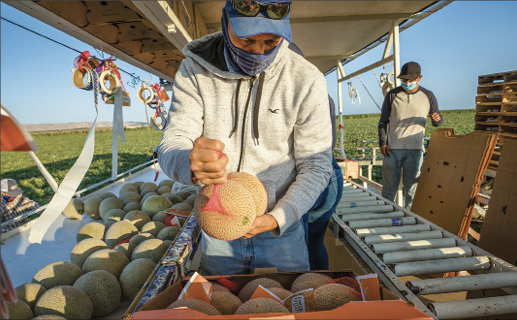Jul 8, 2021Mixed bag for California melon crop reported
As people get back to backyard celebrations this summer, California melon growers say demand for summer staples of watermelons, honeydews, cantaloupes and mixed melons remains high, though getting the crop to market has faced several hiccups this season.
The statewide drought has led to a reduction in total melon acreage due to a lack of surface water.
The state’s primary melon-growing regions – the San Joaquin Valley’s west side and the Imperial Valley – produce about 75% of the nation’s commercially grown melons. The annual melon harvest begins in the Imperial Valley and neighboring Yuma Valley in Arizona in early to mid-May, then progresses north through the San Joaquin Valley.
Fresno County farmer Joe Del Bosque farms in the Westlands Water District, which relies on water from the federal Central Valley Project. He said early in the season he cut back acreage of asparagus to save water for melons. The U.S. Bureau of Reclamation allocated only 5% water supplies to Westlands and other contractors in February, and then suspended that amount a few weeks later.
As the season progressed, Del Bosque learned that an arrangement to deliver transfer water to Westlands Water District was halted to conserve cold water for fish behind Lake Shasta. This forced him to pull back plantings of late-season melons.
“Right now, there’s a lot of uncertainty and I have a lot of fear,” Del Bosque said. “If we have no water and the agencies that move transfer water don’t help us next year, our ranch is going to come to a stop. We’ll have to lay off people and we’ll lose our customers. It could be the end of us.”
In past years of limited water, Del Bosque said delivery of purchased transfer water would happen right away, usually in April or May. This year, the bureau told the district that it would not receive this water until October. Westlands Water District anticipates that approximately 210,000 acres of land within the district will be fallowed this year.
Despite drought-related challenges, Ryan Van Groningen of Van Groningen and Sons—a grower, packer and shipper based in Manteca—said perfect weather during the spring led to larger-sized fruit and high brix.
His grower-partners are wrapping up harvest in the Imperial Valley, and he said he expects to begin harvest of large- and personal-size watermelons at the family farm in Manteca. He said extreme heat can affect yields, noting recent temperatures reaching 120 degrees in El Centro and 106 in Manteca.
“That type of extreme heat will knock off any potential flower or fruit because the plant is stressed,” Van Groningen said.
Another impact to the season, according to growers, is a lack of skilled employees to harvest the crop.
“We’re getting a lot of people that say, ‘We’re not coming back yet; we’d rather stay at home,'” Van Groningen said, adding that finding employees hasn’t been easy.
A shortage of truck drivers also has affected the food-supply chain and melon shipments, growers said.
“Not only is there not enough drivers, but I think that is causing issues with getting enough product to the marketplace,” Van Groningen said. “People can’t get it through the distribution channels fast enough.”
Other challenges, Van Groningen said, include a shortage of shipping supplies such as pallets, bins, cardboard and paper, adding, “Packaging costs are a significant issue. Pallet costs have risen exponentially. A pallet that typically sells for $8 has doubled or tripled in price. It’s a huge impact for us.”
A lack of employees and/or a shortage of pallets, Van Groningen said, has forced growers to make tough decisions about leaving the crop in the field unharvested.
“If you have to pick X amount of product that day and you only have 80% that you can actually handle either because of labor or packaging, you go for the best 80% and then you leave 20%,” Van Groningen said.
Imperial Valley farmer Joe Colace of Five Crowns Marketing – a grower, packer and shipper – described difficulty finding employees, increasing cost of supplies and lack of transportation as daily “pressure points,” adding that these costs have been difficult to bear.
Even with the various challenges of getting the crop grown, harvested and to market, California melon growers say demand remains strong at retail – and now at food service as restaurants reopen.
“It has been such a wonderful thing that people are out enjoying the summer weather and family gatherings,” Colace said. “As restrictions loosen, we’re seeing an uptick in consumption. We have really enjoyed a good-quality season for flavor and sugar of the product, and that always enhances repeat business.”
– Christine Souza, California Farm Bureau Federation
Del Bosque Farms employee Carlos Mercado packs cantaloupes near Firebaugh. California melon farmers report a quality crop and high demand this season, but say impacts of the drought and a shortage of employees and supplies has led to fallowed or unharvested fields for some farms. Photo: Tomas Ovalle

















